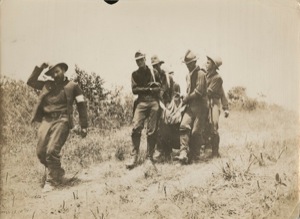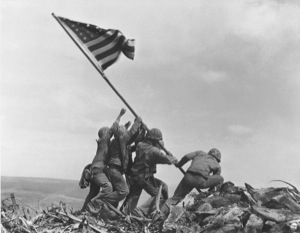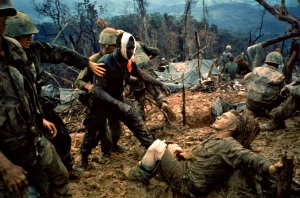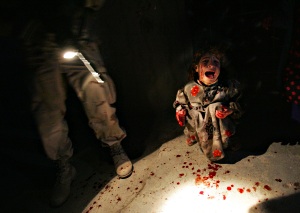Photojournalism: America at War
By Liam Kennedy
The origins of photojournalism in the United States may be traced back to the photographic documenting of westward expansion and of internal and external conflicts that defined the boundaries of the nation and the role of the state in the second half of the nineteenth century. With the ‘tabloid’ coverage of the Spanish-American War in 1898, news photography become intricately tied up with the projection and representation of American’s foreign policy interests.

Harry Ransom Humanities Research Centre
University of Texas at Austin
Jimmy Hare- US Fighters at San Juan Hill
As photojournalism emerged as a distinctive genre in the twentieth century, it came to play an important role in illustrating America’s growing will to power in international arenas. It reflected the triumph of American modernity on a global scale and mirrored an increasingly confident perspective on international affairs. The ‘golden age’ of American photojournalism runs from the mid-1920s to the early 1970s, a period in which picture magazines and news magazines (drawing inspiration and personnel from European examples) came to the fore as the premier conveyors of photojournalistic imagery – Time (1923), Fortune (1929), Newsweek (1933), Life (1936), Look (1937) are the prominent examples.
The camera was central to the broad documentary impulses of the 1930s, conditioned in part by the Depression, and it more often than not promoted the common democracy of the ordinary, often suffering people. The democratic and humanizing aesthetics that are so central to the practice of American documentary photography come powerfully to the fore in this period. This is evident in both domestic and foreign spheres. American photographic coverage of World War II often shows the influence of 1930s documentary photography. Although much imagery conveyed heroic leadership, it was the imagery of the humanity and endurance of ordinary GIs that received more coverage and most celebrated of all was the photograph by Joe Rosenthal of the raising of Old Glory on Mt. Suribachi, on Iwo Jima, in 1945 – this symbol of common man triumphant is widely remembered as the most iconic photograph of the war.

PA Photos
Joe Rosenthal- ‘Old Glory…’, 1945. US Marines place a flag on Mt. Suribachi on 23 February, 1945 following a bloody battle against Japanese forces for control of the island of Iwo Jima.
After the war and still before the era of television, photojournalism was the foremost medium in representing the intersections of national and international affairs and played an important role in illustrating the ‘Western’ worldview in relation to the Cold War. Photojournalism became more thoroughly professionalized in this period and the establishment (in 1947) of Magnum, the international photographic cooperative, set new standards for conscientious international reporting and a humanistic photojournalism that has left a major legacy in the field. Magnum also played an important role in elevating photojournalism into an art form – an elevation that remains controversial.
Even as the Cold War framework conditioned the visualization of US foreign affairs, it also exacerbated anxieties about the international role of the US. This was evident in coverage of the Korean War, as in the series of images taken for Life by David Douglas Duncan of the retreat from the Changjin Reservoir in 1950. Such ambivalence became a more deep-seated disillusionment by the middle of the Vietnam War, in which the relation between the military and the media took on a more overtly adversary cast. With little regulation of their activities, photographers covered many aspects of the war and, while the American GI remained the focus of media attention, cameras also helped reveal failures of American ideology and strategy. Notably, the iconic images of the war - Eddie Adams’ photograph of the execution of a Vietcong prisoner, in 1968; Nick Ut’s photograph of the children fleeing an accidental aerial napalm strike, near Trang Bang, in 1972 - did not resemble those of World War II. They were images of atrocity, and became potent symbols in anti-war protests. Just as notable is the powerfully affective role that such photography has had on the visual memory of the Vietnam War, displacing televisual imagery.
The photojournalists who truly pushed the boundaries of their genre in coverage of the Vietnam War – Larry Burrows, Philip Jones Griffiths, Don McCullin, Henri Huet, Catherine Leroy and Kyoichi Sawada foremost among them– adopted reflective approaches that accentuated narrative and subjective features of their work. Burrows, one of Life’s leading photographers, photographed the war from 1962 until his death in Laos in 1971. During this period, he evolved as a brilliant innovator who produced some of the most dramatic action photography of the war, and mastered the use of colour photography in the photojournalistic scene. During the same period his imagery become darker, registering his growing doubts about the American role in Vietnam.

Larry Burrows/Getty Images
‘Reaching Out’, Vietnam, 1971. Marine gunnery sargeant Jeremiah Purdie staggers towards a wounded colleague during a battle between US Marines and entrenched Viet Cong forces for control of Mutter Ridge, Nui Cay Try, Vietnam, 5 October, 1966.
Griffiths, a much more politicized photographer from the outset, produced an uncompromising vision of the war which no American media would reproduce and so he determined to reproduce it himself as a book, Vietnam Inc, published in 1971. It remains a benchmark of engaged war photography for many photojournalists.
In large part due to military distrust of the media during the Vietnam War, the management of news media intensified during the conflicts involving the US in the 1980s - there were bans on media access to the military invasions of Grenada in 1983 and Panama in 1989. The visual reportage of international affairs was also affected by the broad changes in media production in the 1970s and 1980s as the mass circulation, general interest magazines went out of business and photojournalism lost its most impressive forum. Television had come to dominate the visualization of US foreign affairs and the ‘golden age’ of photojournalism was at an end.
The humanistic photojournalism of the mid-twentieth century did not disappear after the Vietnam War but its authority was widely challenged from within as well as without as a new self-consciousness and reflexivity entered the genre and a new generation of photojournalists emerged to follow the incendiary spots of late Cold War geopolitics, from the Middle East to Latin America. The best of this generation- photographers such as Gilles Peress, James Nachtwey, Susan Meiselas, and Alex Webb- plied their trade even as they sought new ways to use photojournalism. Some sought to reinvigorate the genre through experimenting with technique, disrupting the conventions of composition of the journalistic image and forging a new visual vocabulary to create dynamic, attention-grabbing frames. What came to be called the ‘new photojournalism’ made use of light, colour, and composition that drew on art and advertising photography techniques to lend the images a contemporary pictorialism.
James Nachtwey/VII
‘Relic of Civil War Became a Monument in a Park’, Nicaragua, 1984
What seemed a litmus test of photojournalism’s status and potential came with the first Gulf War, which was also a major test of the post-Vietnam relations between the military and the media. The Department of Defense Pool forced hundreds of reporters to rely on the work of a small group, and photographers who refused to follow the established rules worked at the margins of the war at their own risk. The result was that remarkably little of the media coverage of this short conflict was from the war zone. For many photojournalists, the Gulf War was a major nail in the coffin of documentary photography. Fred Richtin, photo-editor at The New York Times during the war, wrote “The world of Robert Capa and W. Eugene Smith and Don McCullin begins to fade next to the technological wizardry of a “smart” bomb taking its own images….” It was only after the war and then in limited ways that images such as Kenneth Jarecke’s photograph of an incinerated Iraqi soldier were published.
In the 1990s, the rapid development of new visual technologies and media platforms - satellite television, digital imaging, the Internet – presented photojournalists with new challenges and opportunities. The conception of events (already substantially ceded to television) was further supplanted by video and digital image-making and dispersal. Increasingly, news photographs would be frame grabs from video and digital sources. At the same time, professional photojournalism was seriously undermined due to budget cuts and the increased media use of agency and stock images. In the 1990s, two huge photo agencies, Getty Images and Corbis, emerged to cater for the new digital market. In the process they gobbled up the smaller agencies that had supported more independent photojournalism. Professional photojournalism has also been challenged by ‘citizen journalists’ producing on-the-spot imagery of events and submitting these images to the media.
News management also continues to constrain photojournalistic practice. In the recent wars in Afghanistan and Iraq photographers have had the opportunity to be ‘embedded’ with military forces near the front lines, a scenario that led to speculation that photographers would have access to the raw realities of warfare. But, for the most part, photographs from the conflicts in Afghanistan and Iraq have been characterized by a narrow range of recurrent motifs and routinized scenarios. Rather than open up a greater range of photo possibilities, embedding with the troops further reinforced an American-centered perspective - precisely what it was designed to do.

Chris Hondros/Getty Images
‘One Night in Tal Afar’, Iraq 2005. Five-year-old Samar Hassan screams after her parents were killed by US soldiers with the 25th Infantry Division on 18 January, 2005 in Tal Afar, Iraq. The soldiers fired on the Hassan family car when it approached them during a dusk patrol.
However, such news management has not entirely precluded more investigative visual journalism and many photojournalists have worked imaginatively within and against the constraints of the embedded system to produce work that challenges more complacent perceptions of the war and illustrates the cultures of the diverse participants, including the American soldier. At the same time, new sites and uses of visual journalism have emerged to challenge or supplement the more mainstream modes and messages. Perhaps most significant of these are the Internet sites that provide outlets for images not being shown in mainstream media.
Despite frequent predictions of the ‘death of photojournalism’, photographers continue to affirm the power of the photographic image to report and witness violent conflict. Many have had to explore fresh outlets for their work, including the Internet, exhibitions and book publications, and alternative sources of funding, with NGOs proving major funders in recent years. Today, the status and future of photojournalism remain under question, yet its mutations in relation to the new technologies of seeing and the new global scenes it represents, have provided the photojournalistic image with a new currency.
Click here for ‘Photojournalism: America at War’ Bibliography section.
Click here for ‘Photojournalism: America at War’ Links section.


